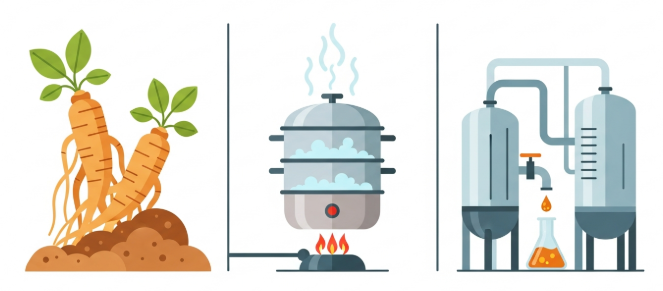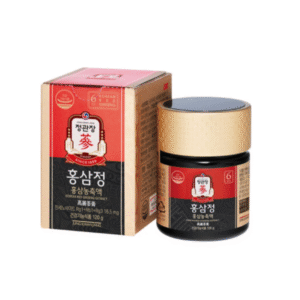At dawn in Geumsan, Korea’s most famous ginseng-producing region, farmers begin their day by carefully inspecting rows of ginseng roots cultivated for years beneath shaded canopies. One of these farmers, Mr. Seo, has followed the same routine his father and grandfather once did—examining the soil, brushing dirt away from the roots, and deciding which ginseng has finally reached maturity.
To him, ginseng isn’t just a crop.
It’s a craft.
A living symbol of Korean heritage.
But as he often says with a proud smile, “Growing ginseng is tradition. Processing it is science.”
Those words capture an important truth: how ginseng is processed dramatically affects its chemical profile, potency, color, flavor, and even its intended use. Traditional steaming, drying, fermenting, and slicing techniques have evolved into highly controlled modern technologies designed to enhance consistency and preserve active compounds.
This article explores the full scientific breakdown of traditional and modern ginseng processing—what changes, why it matters, and how these methods transform a simple white root into the prized Korean Red Ginseng found around the world.
Understanding Ginseng Processing: Why It Matters
Raw ginseng (also known as “fresh ginseng”) contains natural compounds called ginsenosides, along with polysaccharides, amino acids, volatile oils, and antioxidants.
But these compounds are not stable.
Without proper processing, they degrade quickly during storage and transportation.
Processing transforms ginseng in several ways:
- Enhances stability
- Prevents spoilage
- Alters ginsenoside composition
- Creates new beneficial compounds
- Extends shelf life
- Enhances potency and bioavailability
- Defines product categories (fresh, white, red, black, fermented)
This is why the same plant—Panax ginseng—can result in many different products depending on the method used.
1. Fresh Ginseng: The Root in Its Purest Form
Traditional Method
Fresh ginseng is harvested between 4–6 years of growth and used immediately, often in:
- cooking
- teas
- soups
- home remedies
Farmers historically consumed fresh ginseng raw or boiled, believing it provided strong vitality.
Modern Considerations
Fresh ginseng has:
- High moisture content
- Very short shelf life
- Rapid microbial growth potential
- Unstable ginsenoside content
Therefore, it’s rarely exported. Most global consumers never encounter ginseng in this form.
2. White Ginseng: The First Step in Traditional Preservation
Traditional White Ginseng Processing
White ginseng is created by:
- Harvesting fresh 4–6-year-old roots
- Peeling the outer skin
- Sun-drying them naturally
This process removes moisture and slightly alters ginsenoside content.
Historically, white ginseng was the primary export during Korea’s early trade era.
Scientific Characteristics
White ginseng has:
- Lower moisture (12–15%)
- Light flavor
- Mild aroma
- Slightly reduced ginsenoside content
- Good shelf stability
Drying reduces enzymatic breakdown and allows storage for long periods.
Limitations
Drying alone:
- Does NOT create new beneficial compounds
- Does NOT transform ginsenosides into bioactive forms
- Results in milder therapeutic potential than red ginseng
White ginseng is considered simpler and gentler—but less potent.
3. Red Ginseng: The Iconic Korean Method
Korean Red Ginseng (“홍삼”) is the most famous form, created using a traditional steaming technique perfected over 1,000 years.
Traditional Red Ginseng Processing
Classic steps include:
- Selecting mature 6-year-old roots
- Washing and sorting
- Steaming at 90–100°C for several hours
- Drying and shaping
- Aging to stabilize compounds
The root turns brownish-red, with a slightly shiny texture.
Scientific Analysis
Steaming triggers chemical changes:
- Converts unstable ginsenosides into more active forms
- Creates rare compounds like Rg3, Rh1, Rh2, Rg5, Rk1
- Increases antioxidant activity
- Enhances shelf stability
- Alters sugar structures and saponins
Steaming is essentially a natural form of heat-induced biotransformation, improving bioavailability.
Why Red Ginseng Is Considered Superior
Studies show red ginseng has:
- Stronger antioxidant activity
- Stronger adaptogenic properties
- More consistent ginsenoside profiles
- Higher stability for global export
- Stronger flavor and aroma
- Darker, caramel-like notes from heat processing
This traditional steaming method remains the heart of Korean ginseng culture.
4. Modern Red Ginseng Processing: Precision & Standardization
While the traditional method remains respected, modern technology revolutionizes consistency.
Modern Steps Include:
- Controlled steaming chambers
- Automated temperature regulation
- Hygienic stainless-steel equipment
- Dehumidifying dryers
- Computerized moisture monitoring
- Chemical profile testing
- Microbial safety testing
- Ginsenoside standardization
Benefits of Modernization
- Greater reproducibility
- Higher purity
- Reduced contamination risk
- Enhanced ginsenoside consistency
- International safety compliance
- Suitability for capsules, extracts, tonics, and powders
Traditional Korean wisdom + modern safety standards = globally trusted ginseng.
5. Black Ginseng: A Newer, More Intense Evolution
Modern research led to black ginseng, which is produced by steaming red ginseng nine times.
What Changes?
Repeated steaming dramatically increases rare ginsenosides:
- Rg3
- Rg5
- Rk1
- Rh3
These compounds are studied for their strong adaptogenic and antioxidant properties.
Characteristics
- Dark black color
- Strong aroma
- Higher bioactive potential
- More modern and specialized
Black ginseng is the most chemically transformed form and considered “high-intensity” ginseng.
6. Fermented Ginseng: Enhancing Bioavailability
Fermentation is a modern bioprocessing method using probiotics or enzymes.
Why Fermentation?
Some ginsenosides (like Rb1, Rc, Rd) are large molecules that are hard to absorb. Fermentation breaks them into smaller, more absorbable forms such as Compound K, which is highly researched.
Benefits
- Faster absorption
- Gentler on the stomach
- Enhanced bioavailability
- Increased adaptogenic potential
Fermented ginseng is increasingly popular worldwide.
7. Extraction & Concentrates: Scientific Precision
Modern ginseng products undergo:
- Low-heat extraction
- Alcohol or water extraction
- Concentration
- Purification
- Standardization (often 3–5% ginsenosides)
These methods make ginseng:
- easier to dose
- more consistent
- suitable for capsules and drinks
- stable for worldwide distribution
Traditional vs. Modern Methods: Key Comparison Table
| Processing Method | Traditional Characteristics | Modern Characteristics |
|---|---|---|
| White Ginseng | Sun-dried | Machine-dried, controlled |
| Red Ginseng | Steamed in large vats | Steamed with automated temperature |
| Black Ginseng | Rare, artisanal | Multi-step standardized steaming |
| Fermented | Not traditional | Probiotic/enzyme-based biotransformation |
| Extracts | Decoctions/teas | High-precision standardized concentrates |
| Testing | Visual inspection | Full chemical & microbial testing |
Which Processing Method Is the Best?
The “best” method depends on the intended purpose:
- For traditional wellness: Red ginseng
- For mild use: White ginseng
- For maximum potency: Black ginseng
- For fast absorption: Fermented ginseng
- For precise dosing: Extracts/capsules
All forms originate from the same plant—but processing transforms the experience.
Conclusion: Tradition Meets Science
Ginseng processing has evolved from ancient steaming pots to modern biotechnology labs, but the essence remains unchanged: preserving and maximizing the root’s natural potential.
Traditional wisdom provides cultural depth.
Modern science provides consistency and safety.
Together, they create the Korean Red Ginseng trusted worldwide today.







